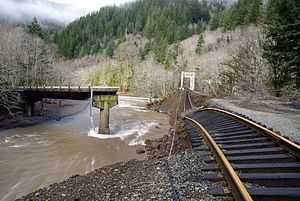Salmonberry River
| Salmonberry River | |
 The Salmonberry River and the damaged Port of Tillamook Bay Railroad in February 2008 | |
| Name origin: Salmonberry plant, Rubus spectabilis | |
| Country | United States |
|---|---|
| State | Oregon |
| County | Tillamook |
| Source | |
| - location | Tillamook State Forest, Northern Oregon Coast Range |
| - elevation | 2,090 ft (637 m) [1] |
| - coordinates | 45°44′44″N 123°23′34″W / 45.74556°N 123.39278°W [2] |
| Mouth | Nehalem River |
| - elevation | 236 ft (72 m) [2] |
| - coordinates | 45°45′03″N 123°39′12″W / 45.75083°N 123.65333°WCoordinates: 45°45′03″N 123°39′12″W / 45.75083°N 123.65333°W [2] |
| Length | 20 mi (32 km) [3] |
| Basin | 66 sq mi (171 km2) [4] |
| Discharge | |
| - average | 350 cu ft/s (10 m3/s) [3] |
|
Location of the mouth of Salmonberry River in Oregon
| |
The Salmonberry River is a tributary of the Nehalem River, about 20 miles (32 km) long, in northwest Oregon in the United States.[3] It drains a remote unpopulated area of the Northern Oregon Coast Range in the Tillamook State Forest about 65 miles (105 km) west-northwest of Portland. The river runs through part of the region devastated between 1933 and 1951 by a series of wildfires known as the Tillamook Burn.[5]
It rises in northeastern Tillamook County, near its border with Washington County, and flows west-northwest through the mountains, joining the Nehalem from the southeast about 15 miles (24 km) northeast of the city of Nehalem.[6]
The river's name comes from the salmonberry plant, Rubus spectabilis.[7]
Railroad
An excursion railway and dinner train, the Oregon Coast Scenic Railroad (OCSR), travels up the Nehalem River canyon from Wheeler to the mouth of the Salmonberry.[8] The train to the Salmonberry is part of an excursion-train network operated by the OCSR, a non-profit organization run by volunteers, on track formerly used by the Southern Pacific Railroad and the Port of Tillamook Bay Railroad.[9] The railway track continues up the Salmonberry for 14 miles (23 km), but flooding and erosion damaged it so severely that it was closed in 2007.[3]
.jpg)
The Wild Salmon Center and other conservation groups concerned about salmon and steelhead runs on the Nehalem and the Salmonberry prefer that the track along the Salmonberry remain closed.[3] Of particular concern are landslides and herbicide spraying along the railway tracks in the river's riparian zones.[4] Both kinds of incursion can harm fish and incubating fish eggs.[4]
See also
References
- ↑ Source elevation derived from Google Earth search using GNIS source coordinates.
- ↑ 2.0 2.1 2.2 "Salmonberry River". Geographic Names Information System (GNIS). United States Geological Survey. November 28, 1980. Retrieved April 28, 2012.
- ↑ 3.0 3.1 3.2 3.3 3.4 Palmer, Tim (2014). Field Guide to Oregon Rivers. Corvallis: Oregon State University Press. pp. 83–84. ISBN 978-0-87071-627-0.
- ↑ 4.0 4.1 4.2 "Proposing Solutions to the Landslide-Prone Railroad on the Salmonberry River" (PDF). The Wild Salmon Center. 2008. Retrieved April 29, 2012.
- ↑ Decker, Doug. "Tillamook Burn". Oregon Encyclopedia. Portland State University and the Oregon Historical Society. Retrieved November 15, 2014.
- ↑ Oregon Road and Recreation Atlas (5th ed.). Santa Barbara, California: Benchmark Maps. 2012. p. 34. ISBN 978-0-929591-62-9.
- ↑ McArthur, Lewis A.; Lewis L. McArthur, eds. (1992) [1928]. Oregon Geographic Names (6th ed.). Portland, Oregon: Oregon Historical Society Press. p. 738. ISBN 0-87595-236-4.
- ↑ "Oregon Coast Scenic Railroad". Oregon Coast Scenic Railroad. May 5, 2014. Retrieved November 15, 2014.
- ↑ "About Us". Oregon Coast Scenic Railroad. May 9, 2014. Retrieved November 15, 2014.